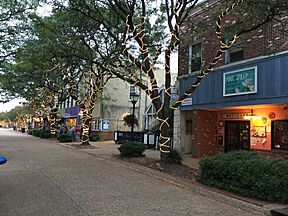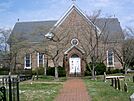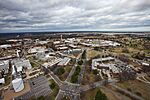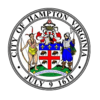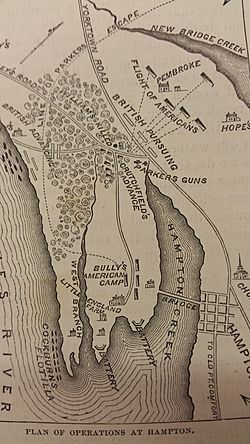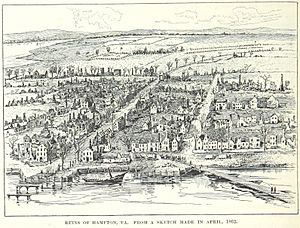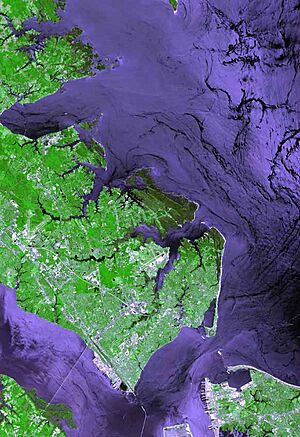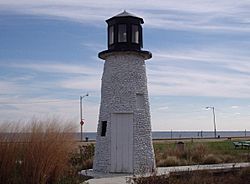Hampton, Virginia facts for kids
Quick facts for kids
Hampton, Virginia
|
|||
|---|---|---|---|
|
Downtown Hampton
Hampton Coliseum
|
|||
|
|||
| Motto(s):
From the Sea to the Stars
|
|||
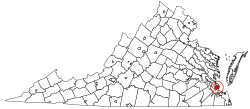
Location in the State of Virginia
|
|||
| Country | United States | ||
| State | Virginia | ||
| County | None (Independent city) | ||
| Settled | 1610 | ||
| Incorporated (town) | 1705 | ||
| Incorporated (city) | 1849 | ||
| Government | |||
| • Type | Mayor–council–manager | ||
| Area | |||
| • Independent city | 136.27 sq mi (352.95 km2) | ||
| • Land | 51.46 sq mi (133.28 km2) | ||
| • Water | 84.81 sq mi (219.67 km2) 62.3% | ||
| Elevation | 10 ft (3 m) | ||
| Population
(2020)
|
|||
| • Independent city | 137,148 | ||
| • Rank | 200th in the United States 7th in Virginia |
||
| • Density | 2,665.14/sq mi (1,029.02/km2) | ||
| • Metro | 1,799,674 | ||
| Time zone | UTC−5 (EST) | ||
| • Summer (DST) | UTC−4 (EDT) | ||
| ZIP Codes |
23661, 23663-23669
|
||
| Area code(s) | 757, 948 | ||
| FIPS code | 51-35000 | ||
| GNIS feature ID | 1495650 | ||
| Public transportation | Hampton Roads Transit | ||
| Website | http://www.hampton.gov | ||
Hampton is a city in Virginia, United States. It's called an independent city because it's not part of any county. In 2020, about 137,148 people lived there, making it the seventh-largest city in Virginia. Hampton is part of a bigger area called Hampton Roads, which is home to over 1.7 million people. This area is known as "America's First Region."
Hampton has a long history, starting at Old Point Comfort. This is where Fort Monroe is located. Explorers led by Captain Christopher Newport first saw this spot in 1607. They later started Jamestown, the first English settlement in America. In 1952, Hampton joined with Elizabeth City County and the town of Phoebus.
After the American Civil War, Hampton University was founded. It helped educate many formerly enslaved people and Native Americans. In the 20th century, Langley Air Force Base, NASA Langley Research Center, and the Virginia Air and Space Center were built here. Hampton also has many miles of beautiful waterfront and beaches.
The city has lots of businesses, shops, homes, and historical places. You can find a NASCAR race track, St. John's Church (one of the oldest churches in America from 1610), and a large, historic fort called Fort Monroe.
Contents
- Exploring Hampton's Past: A History Journey
- Hampton's Location and Climate
- People of Hampton: Demographics
- Fun in Hampton: Arts and Culture
- Sports in Hampton: Get Active!
- Learning in Hampton: Education
- Hampton's Media: News and Entertainment
- Getting Around Hampton: Transportation
- Famous People from Hampton
- Hampton's Sister Cities
- Images for kids
- See also
Exploring Hampton's Past: A History Journey
Hampton has been home to people for a very long time. Native Americans lived here over 12,000 years ago. In the early 1600s, the Powhatan people lived in the area. They called their land Tsenacommacah. There were over 30 Powhatan tribes, with about 25,000 people, before English settlers arrived.
How Hampton Began: Colonial Times
In December 1606, three ships left England. They were carrying men and boys, sent by a company to start a new settlement. Captain Christopher Newport led them across the Atlantic Ocean. They first landed in North America at a place they named Cape Henry.
During their first explorations, they found Old Point Comfort. They saw it was a great spot to defend the entrance to Hampton Roads. This area is where the Elizabeth, Nansemond, and James rivers meet. The James River is the longest in Virginia.
A few weeks later, on May 14, 1607, they built the first lasting English settlement in what is now the United States. This was about 25 miles (40 km) inland, at Jamestown.
In 1610, the colonists took over the Native American village of Kecoughtan. This was near the Hampton River. They built a small town there, with a church that is now St. John's Episcopal Church. This area became part of Hampton. Since Jamestown was later abandoned, Hampton claims to be the oldest continuously lived-in English settlement in the U.S.
Hampton was named after Henry Wriothesley, 3rd Earl of Southampton. He was an important leader of the Virginia Company of London. The Hampton River, Hampton Roads, and Southampton County were also named after him. By 1680, the settlement was known as Hampton. It became a town in 1705 and the main town for Elizabeth City County.
In August 1619, a ship called the White Lion arrived at Point Comfort. It brought about 20 people from Africa. They had been taken from a Portuguese ship. These were the first recorded people of African descent to arrive in the English colonies. They were treated as servants, but soon became enslaved. Two of these first arrivals were Anthony and Isabella. Their child, born in January 1624, was the first person of African descent born in North America.
Hampton After the Colonies: Modern History
In 1813, the British captured the fort at Old Point Comfort during the War of 1812. After the war, the U.S. Army built a stronger stone fort there. It was named Fort Monroe after President James Monroe. This fort and another one nearby were finished in 1834. Fort Monroe is the largest stone fort ever built in the United States.
Hampton and Fort Monroe played key roles in the American Civil War (1861–1865). Even though most of Virginia joined the Confederate States of America, Fort Monroe stayed under Union control. It became a safe place for people who had been enslaved. After the war, former Confederate President Jefferson Davis was held prisoner at the fort.
The town of Hampton was attacked and burned during the American Revolutionary War, the War of 1812, and the Civil War. After the Civil War, formerly enslaved people built the Grand Contraband Camp from the ruins of Hampton. This was the first self-contained African American community in the U.S. Many streets in Hampton today are named after parts of that community. The large number of people seeking safety at Fort Monroe led to the creation of Hampton University.
Hampton officially became a city in 1849. In 1908, it became an independent city, separate from Elizabeth City County. However, it still served as the county seat. Then, in 1952, Hampton, the town of Phoebus, and Elizabeth City County all joined together to form the independent city of Hampton. This was one of the first times cities in the Hampton Roads area merged.
Hampton's Military Story: 20th Century and Beyond
Hampton has a strong military history, especially in the 20th century. It is home to Langley Air Force Base, the first military base in the country just for air power. It has been a center for military aviation training and research for almost 100 years. This includes everything from early planes and airships to rockets and advanced fighter jets. Because it's close to Norfolk, many Navy families also live in Hampton.
Fort Monroe was an active army base until it closed on September 15, 2011. Soon after, President Barack Obama declared it a National Monument.
Langley Air Force Base During the Vietnam War
During the Vietnam War, Langley Air Force Base was a "waiting base." Thousands of Air Force families moved to Hampton to wait while their loved ones served in Vietnam. Many Navy families from nearby Norfolk also waited in Hampton. The Vietnam War had a high number of casualties for Air Force and Navy pilots. Many families in Hampton waited for years to find out what happened to their missing or captured family members.
Hampton's Location and Climate
Hampton covers about 136 square miles (352 square kilometers). About 51 square miles (133 square kilometers) is land, and 85 square miles (220 square kilometers) is water. This means a large part of the city is water!
Hampton's Neighborhoods
Hampton has many different neighborhoods, including:
- Aberdeen Gardens
- Buckroe Beach
- Fox Hill
- Phoebus
- Wythe
Hampton's Weather: What to Expect
Hampton has a humid subtropical climate. This means it has hot and humid summers and mild winters. The average yearly temperature is about 60.2°F (15.7°C). On average, Hampton gets about 6 inches (152 mm) of snow and 47 inches (1,194 mm) of rain each year. The hottest day ever recorded was August 1, 1980, when it reached 105.1°F (40.6°C). The coldest day was January 21, 1985, at -2.7°F (-19.3°C).
People of Hampton: Demographics
In 2010, there were 137,436 people living in Hampton. The city had 53,887 households. About 32.5% of households had children under 18. The average household had 2.49 people.
The population's age breakdown was:
- 24.2% under 18
- 12.6% from 18 to 24
- 32.5% from 25 to 44
- 20.4% from 45 to 64
- 10.3% were 65 or older
The average age in Hampton was 34 years.
Fun in Hampton: Arts and Culture
Arts and Museums: Exploring Creativity and History
Hampton has many places to enjoy art and learn about its history. Some popular spots include:
- The American Theatre
- The Casemate Museum
- The Charles Taylor Visual Arts Center
- The Hampton History Museum
- The Hampton University Museum
- The Virginia Air & Space Center
The Hampton Coliseum is a large arena built in 1968. It hosts many events like Monster Jam, WWE wrestling, and concerts by famous artists like Bruce Springsteen and The Rolling Stones. It can hold between 9,800 and 13,800 people.
Libraries: A World of Books
The Hampton Public Library serves the city. It started in 1926 as Virginia's first free county library. Today, it has a main library and three smaller branches.
Points of Interest: What to See and Do
Sports in Hampton: Get Active!
The Peninsula Pilots are a summer baseball team based in Hampton. They play at War Memorial Stadium. The Hampton University Pirates & Lady Pirates compete in Division I college sports.
High school sports are very popular in Hampton, especially football and basketball. Famous athletes like Allen Iverson and Francena McCoroy are from Hampton. Darling Stadium is where high school football games are played.
You can also find more sports nearby. Colleges like College of William and Mary, Norfolk State University, and Old Dominion University have Division I teams. For professional sports, the Norfolk Tides (baseball) and Norfolk Admirals (hockey) play in Norfolk.
Learning in Hampton: Education
Public Schools: Learning for Everyone
Hampton City Public Schools provides public education. There are four high schools: Kecoughtan, Bethel, Phoebus, and Hampton. The city also has 18 elementary schools, two PK-8 schools, five middle schools, and special centers for early childhood and gifted students.
Colleges and Universities: Higher Education Opportunities
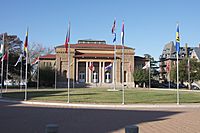
Hampton is home to Hampton University and Virginia Peninsula Community College. Other universities nearby include Christopher Newport University, Old Dominion University, Norfolk State University, and The College of William and Mary.
Hampton's Media: News and Entertainment
Hampton's daily newspaper is the Daily Press. Other papers like The Virginian-Pilot also serve the area. Coastal Virginia Magazine is a regional magazine. Hampton also has many radio stations.
For television, Hampton is part of a large viewing area. Major TV channels include WTKR (CBS), WAVY (NBC), WVEC (ABC), and WVBT (Fox). You can also watch public broadcasting on WHRO-TV. Hampton residents get TV service from Verizon FiOS and Cox Cable.
Getting Around Hampton: Transportation
Roads and Highways: Connecting the City
Crossing water is a big part of travel in the Hampton Roads area. Hampton has many local roads and bridges. Many bridges along Mercury Boulevard are named after the first NASA astronauts.
Hampton is connected to nearby cities like Newport News and Poquoson. You can easily travel to Williamsburg and Yorktown too. To reach other cities in the South Hampton Roads area, you need to cross the water. There are three main ways to do this by car:
- The Hampton Roads Bridge–Tunnel (HRBT) on Interstate 64.
- The Monitor–Merrimac Memorial Bridge–Tunnel (MMMBT) on Interstate 664.
- The James River Bridge in Newport News, which connects to Isle of Wight County.
Major highways in Hampton include U.S. Routes 17, 60, and 258.
Public Transportation: Buses and Trains
The Hampton Transit Center is a hub for local and long-distance public transport. It has buses from Hampton Roads Transit (HRT), Greyhound Lines services, and taxis. HRT offers bus service within Hampton and to seven other cities in Hampton Roads.
Amtrak trains serve Hampton from the Newport News station. You can travel directly to cities like Williamsburg, Richmond, Washington D.C., Baltimore, Philadelphia, and New York City. From Richmond, you can connect to other Amtrak destinations across the country.
Airports: Flying In and Out
Hampton is served by two main airports:
- Newport News/Williamsburg International Airport (PHF) in Newport News. This airport is growing fast.
- Norfolk International Airport (ORF) across the harbor in Norfolk. This is a larger airport with flights to many destinations.
Famous People from Hampton
Many notable people have come from Hampton, including:
- James Armistead, America's first African American spy during the Revolutionary War.
- Samuel Chapman Armstrong, founder of Hampton University.
- Mary S. Peake, an important African American teacher and humanitarian.
- Booker Taliaferro Washington, a famous educator and author.
- Mary Jackson and Katherine Johnson, brilliant mathematicians and engineers who worked for NASA.
- Allen Iverson, a famous basketball player.
- Tyrod Taylor, a professional football quarterback.
- Mike Tomlin, a professional football coach.
Hampton's Sister Cities
Hampton has special connections with four other cities around the world:
 Southampton, England, United Kingdom
Southampton, England, United Kingdom Vendôme, France
Vendôme, France Pietermaritzburg, South Africa
Pietermaritzburg, South Africa Anyang, Gyeonggi, South Korea
Anyang, Gyeonggi, South Korea
Images for kids
See also
 In Spanish: Hampton (Virginia) para niños
In Spanish: Hampton (Virginia) para niños


